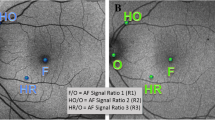Abstract
Purpose. Hypofluorescent spots were seen inindocyanine green (ICG) angiography of peau d‘orangefundus in eyes with angioid streaks. Origin of the hypofluorescentspots were examined with attention to their correlationwith a peau d‘orange appearance of the central fundususing a computer-assisted image comparison system. Methods. ICG angiography was performed in 5 patientshaving peau d‘orange appearance of fundus using ascanning laser ophthalmoscope (SLO) and a digitalvideo-fundus camera. The same central fundus areas corresponding to hypofluorescent spots in an ICGangiogram were then digitally identified in afluorescein angiogram and in a red-free picture in all10 eyes of the 5 patients. Monochromatic lightobservation was also performed with a dark fieldobservation using a SLO to see subretinal orintrachoroidal pigment clumping. Results. In no patient, the areas identified withhypofluorescent spots did show relevant changes ina fluorescein angiogram or a red-free picture. SLOexamination revealed not perfusion defect at the sameareas. The dark field observation showed no pigmentclumping at the peripapillary and papillomacularbundle regions where hypofluorescent spots were seen.Conclusions: Hypofluorescent spots seen in ICGangiograms did not show exact consistency with peau d‘orange changes in their location and shape. Perfusion defects or blocking by pigments were not acause of hypofluorescent spots. The scatteredhypofluorescent spots were considered to be relevantwith irregular affinity of the fundus to ICG dye.
Similar content being viewed by others
References
Smith JL, Gass JDM, Justice J. Fluorescein fundus photography of angioid streaks. Br J Ophthalmol 1964; 48: 517–21.
Shimizu K. Mottled fundus in association with pseudoxanthoma elasticum. Jpn J Ophthalmol 1961; 5: 1–13.
Gills JP Jr, Paton D. Mottled fundus oculi in pseudoxanthoma elasticum: a report on two siblings. Arch Ophthalmol 1965; 73: 792–5.
Krill AE, Klien BA, Archer DB. Precursors of angioid streaks. Am J Ophthalmol 1973; 76: 875–9.
Gass J. Donald M. Stereoscopic atlas of macular diseases: diagnosis and treatment, 3rd ed. St. Louis: CV Mosby, 1987; 102–9.
Paton D. The relation of angioid streaks to systemic disease. Springfield: C.C. Thomas, 1972.
Beighton P, editor. McKusick’s heritable disorders of connective tissue. 5th ed. St. Louis: Mosby, 1993.
Quaranta M, Cohen SY, Krot R, et al. Indocyanine green videoangiography of angioid streaks. Am J Ophthalmol 1995; 119: 136–42.
Clarkson JG, Altmen RD. Angioid streaks. Surv Ophthalmol 1982; 26: 235–46.
McDonald HR, Schatz H, Aaberg TM. Reticular-like pigmentary patterns in pseudoxanthoma elasticum. Ophthalmology 1988; 95: 306–11.
Kim DD, Pulido JS, Wipplinger WA. Indocyanine green angio-graphic findings in pseudoxanthoma elasticum. Am J Ophthalmol 1993; 116: 767–9.
Woong WH, Fitzke FW, Bird AC, Marshall J. Confocal imaging of the fundus using a scanning laser ophthalmoscope. Br J Ophthalmol 1992; 76: 470–4.
Hartnett ME, Elsner AE. Characteristics of exudative agerelated macular degeneration determined in vivo with confocal and indirect infrared imaging. Ophthalmology 1996; 103: 58–71.
Kohno T, Miki T, Shiraki, K, Moriwaki M. Indocyanine green angiography in choriocapillary atrophy induced by sodium iodate. Graefe’s Arch Clin Exp Ophthalmol 1995; 233: 642–8.
Gass JDM, Clarkson JG. Angioid streaks and disciform macular detachment in Paget’s disease (Osteitis Deformans). Am J Ophthalmol 1973; 75: 576–86.
Flower RT. Binding and extravasation of indocyanine green dye. Retina 1994; 14: 283–4.
Klien BA. Angioid streaks. A clinical and histopathologic study. Am J Ophthalmol 1947; 30: 955–68.
Hussain AA, Howe L, Marshall J. Indocyanine green binding to plasma proteins and proteins extracted from human Bruch’s-choroid. Invest Ophthalmol Vis Sci 1996; S1128, ARVO abstract.
Author information
Authors and Affiliations
Rights and permissions
About this article
Cite this article
Shiraki, K., Moriwaki, M., Matsumoto, M. et al. Hypofluorescent spots in indocyanine green angiography of peau d‘orange and fundus. Int Ophthalmol 21, 43–50 (1997). https://doi.org/10.1023/A:1005898714237
Issue Date:
DOI: https://doi.org/10.1023/A:1005898714237




